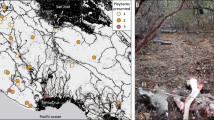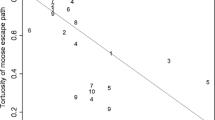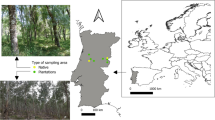Abstract
Human presence (e.g. hunting, ecotourism and wildlife photography) affects animal behaviour. Hunting pressure increases the perception of predation risk in ungulates and hares and may force them to create clumped groups within protected areas. Acute effects are showed immediately after harassments and may include displacement of home ranges, alteration of activity rhythms and increased hormone secretions. No study has been carried out yet on behavioural alterations induced by hunting on non-target, legally protected species, whereas these studies should be required to design addressed management and conservation plans. The crested porcupine Hystrix cristata represents a suitable model species to study effects of hunting on protected species, as its ranging movements and activity rhythms are seasonally, stereotypically repeated. My results on individually marked porcupines showed that, when hunting with dogs occurred, a displacement of home range arises towards areas providing easily accessible food resources (i.e. fruits, which do not require digging). This behaviour might prevent porcupines to spend a high amount of time digging bulbs and tubers and, thus, it may result in a reduction of activity bouts. Home range displacement has also been observed only when >10 cm of snow are present on the ground. The presence of hunting dogs increases the predation risk perception by potential prey species, which in turn respond by altering their spatio-temporal behaviour. Wildlife managers should therefore evaluate the use of a small number of specialized dogs for hunting in management and conservation plans, particularly in areas characterized by the presence of endangered and protected species.
Similar content being viewed by others
References
Agresti A (2002) Categorical data analysis. Wiley, Hoboken
Alkon PU, Saltz D (1988) Foraging time and the northern range limits of Indian crested porcupines (Hystrix indica). J Biogeogr 15:403–408
Apostolico F, Vercillo F, La Porta G, Ragni B (2016) Long-term changes in diet and trophic niche of the European wildcat (Felis silvestris silvestris) in Italy. Mamm Res 61:109–119
Barrios-Garcia MN, Ballari SA (2012) Impact of wild boar (Sus scrofa) in its introduced and native range: a review. Biol Inv 14:2283–2300
Bateson PPG, Bradshaw EL (1997) Physiological effects of hunting red deer (Cervus elaphus). Proc of R Soc 264:1707–1714
Bertolino S, Colangelo P, Mori E, Capizzi D (2015) Good for management, not for conservation: an overview of research, conservation and management of Italian small mammals. Hystrix 26:25–35
Brandt S, Vassant J, Jullien JM (1998) Domaine vital diurne des sangliers en forêt de Châteauvillain-Arc-en-Barrois. Bulletin Mensuel Office National Chasse 234:4–11
Bruno E, Riccardi C (1995) The diet of the crested porcupine Hystrix cristata L., 1758 in a Mediterranean rural area. Z Säugetierk 60:226–236
Calenge C (2006) The package adehabitat for the R software: a tool for the analysis of space and habitat use by animals. Ecol Model 197:516–519
Christiansen F, Lusseau D (2015) Linking behavior to vital rates to measure the effects of non-lethal disturbance on wildlife. Conserv Lett 8:424–431
Corsini MT, Lovari S, Sonnino S (1995) Temporal activity patterns of crested porcupines Hystrix cristata. J Zool Lond 236:43–54
Crawley M (2007) The R book. Wiley, Chichester
Cromsigt JPGM, Kujper DPJ, Adam M, Beschta RL, Churski M, Eycott A, Kerley GIH, Mysterud A, Schmidt K, West K (2013) Hunting for fear: innovating management of human-wildlife conflict. J Appl Ecol 50:544–549
Cushman JH, Tierney TA, Hinds JM (2004) Variable effects of feral pig disturbances on native and exotic plants in a California grassland. Ecol Appl 14:1746–1756
Cuzin F (2003) Les grands mammifères du Maroc méridional (Haut Atlas, Anti Atlas et Sahara): Distribution, Ecologie et Conservation. Ph.D. Thesis, Laboratoire de Biogéographie et Ecologie des Vertèbrés, Ecole Pratique des Hautes Etudes, Université Montpellier II, France
De Boer HY, van Breukelen L, Hootsman MJM, van Wieren SE (2004) Flight distance in roe deer Capreolus capreolus and fallow deer Dama dama as related to hunting and other factors. Wildl Biol 10:35–41
Dray S, Dufour AB (2007) The ade4 package: implementing the duality diagram for ecologists. J Stat Soft 22:1–20
Fattorini L, Pisani C, Riga F, Zaccaroni M (2014) A permutation-based combination of sign tests for assessing habitat selection. Envir Ecol Stat 21:161–187
Fattorini L, Pisani C, Riga F, Zaccaroni M (2017) The R package “phuassess” for assessing habitat selection using permutation-based combination of sign tests. Mammal Biol 83:64–70
Fowler GS (1999) Behavioral and hormonal responses of Magellanic penguins (Spheniscus magellanicus) to tourism and nest site visitation. Biol Conserv 90:143–149
Gelman A (2008) Scaling regression inputs by dividing by two standard deviations. Stat Med 27:2865–2873
Green R, Higginbottom K (2001) Negative effects of wildlife tourism on wildlife. Gold Coast. CRC for Sustainable Tourism, Sidney, Australia
Grignolio S, Merli E, Bongi P, Ciuti S, Apollonio M (2011) Effects of hunting with hounds on a non-target species living a the edge of a protected area. Biol Conserv 144:641–649
Hammerschlag N, Gallagher AJ, Wester J, Luo J, Ault JS (2012) Don’t bite the hand that feeds: assessing ecological impacts of provisioning ecotourism on an apex marine predator. Funct Ecol 26:567–576
Ivlev VS (1961) Experimental ecology of the feeding of fishes. Yale University Press, New Haven
Jeppesen JL (1998) Impact of human disturbance on home range, movements and activity of red deer (Cervus elaphus) in a Danish environment. Dan Rev Game Biol 13:1–38
Jullien JM, Brandt S, Vassant J, Chantecaille S (1991) Des sangliers chassés en battue en forêt demaniale de Châteauvillain-Arc-en-Barrois: leurs «stratégies» pour échapper aux chasseurs et aux chiens. Bulletin Mensile Office National de la Chasse 162:29–36
Kamler JF, Jedrzejewska B, Jedrzejewska W (2007) Activity patterns of red deer in Bialowieza National Park, Poland. J Mamm 88:508–514
Kilgo JC, Labisky RF, Fritzen DE (1998) Influences of hunting on the behaviour of white-tailed deer: implications for conservation of the Florida panther. Cons Biol 12:1359–1364
Laurenzi A, Bodino N, Mori E (2016) Much ado about nothing: assessing the impact of a problematic rodent on agriculture and native trees. Mamm Res 61:65–72
Lovari S, Sforzi A, Mori E (2013) Habitat richness affects home range size in a monogamous large rodent. Behav Proc 99:42–46
Lovari S, Corsini MT, Guazzini B, Romeo G, Mori E (2017) Suburban ecology of the crested porcupine: a global approach. Eur J Wildl Res 63:10. doi:10.1007/s10344-016-1075-0
Maillard D, Fournier P (1995) Effects of shooting with hounds on size of resting range of wild boar (Sus scrofa L.) groups in Mediterranean habitat. Ibex, J Mount Ecol 3:102–107
Massolo A, Sforzi A, Lovari S (2003) Chemical immobilization of crested porcupine with Tiletamine HCl and Zolazepam HCl (Zoletil®) under field condition. J Wildl Dis 39:727–731
Massolo A, Dani FR, Bella N (2009) Sexual and individual cues in the peri-anal gland secretum of crested porcupines (Hystrix cristata). Mamm Biol 74:488–496
Mattisson J, Sand H, Wabakken P, Gervasi V, Liberg O, Linnell JDC, Rauset GR, Pedersen HC (2013) Home range size variation in a recovering wolf population: evaluating the effect of environmental, demographic, and social factors. Oecologia 173:813–825
Monaco A, Franzetti B, Pedrotti L, Toso S (2003) Linee guida per la gestione del cinghiale. Ministero Politiche Agricole e Forestali, Istituto Nazionale per la Fauna Selvatica, Ozzano nell’Emilia (Bologna) e Roma, Italy
Monetti L, Massolo A, Sforzi A, Lovari S (2005) Site selection and fidelity by crested porcupine for denning. Ethol Ecol Evol 17:149–159
Mori E, Sforzi A, Di Febbraro M (2013) From the Apennines to the alps: recent range expansion of the crested porcupine Hystrix cristata L., 1758 (Mammalia: Rodentia: Hystricidae) in Italy. It J Zool 80:469–480
Mori E, Nourisson DH, Lovari S, Romeo G, Sforzi A (2014a) Self-defence may not be enough: moonlight avoidance in a large, spiny rodent. J Zool, London 294:31–40
Mori E, Maggini I, Menchetti M (2014b) When quills kill: the defense strategy of the crested porcupine Hystrix cristata L., 1758. Mammalia 78:229–234
Mori E, Lovari S, Sforzi A, Romeo G, Pisani C, Massolo A, Fattorini L (2014c) Patterns of spatial overlap in a monogamous large rodent, the crested porcupine. Behav Proc 107:112–111
Mori E, Menchetti M, Dondini G, Biosa D, Vergari S (2014d) Theriofauna of site of community importance Poggi di Prata (Grosseto, Central Italy): terrestrial mammals and preliminary data on Chiroptera. Check List 10:718–723
Mori E, Menchetti M, Balestrieri A (2014e) Interspecific den sharing: a study on European badger setts using camera traps. Acta Ethologica 28:121–126
Mysterud A (2013) Ungulate migration, plant phenology, and large carnivores: the times they are a-changin. Ecology 94:1257–1261
Nemeth E, Pieretti N, Zollinger SA, Geberzahn N, Partecke J, Miranda AC, Brumm H (2013) Bird song and anthropogenic noise: vocal constraints may explain why birds sing higher-frequency songs in cities. Proc R Soc B 280:20122798
Ohashi H, Saito M, Horie R, Tsunoda H, Noba H, Ishii H, Kuwabara T, Hiroshige Y, Koike S, Hoshino Y, Toda H, Kaji K (2013) Differences in the activity pattern of the wild boar Sus scrofa related to human disturbance. Eur J Wildl Res 59:167–177
Pigozzi G (1988) Quill-marking, a method to identify crested porcupines individually. Acta Theriol 33:138–142
Pirotta E, Lusseau D (2015) Managing the wildlife tourism commons. Ecol Appl 25:729–741
Pirotta E, New L, Harwood J, Lusseau D (2014) Activity, motivations and disturbance: an agent-based model of bottlenose dolphin behavioral dynamics and interactions with tourism in doubtful sound, New Zealand. Ecol Model 282:44–58
Pirotta E, Merchant ND, Thompson PM, Barton TM, Lusseau D (2015) Quantifying the effect of boat disturbance on bottlenose dolphin foraging activity. Biol Conserv 181:82–89
Reimers E, Loe LE, Eftestol S, Colman JE, Dahle B (2009) Effects of hunting on response behaviors of wild reindeer. J Wildl Manag 73:844–851
Ripley B, Venables W (2015) R-package nnet: Feed-forward neural networks and multinomial log-linear models. ftp://ftp.ussg.iu.edu/pub/CRAN/web/packages/nnet/nnet.pdf. Accessed 03 Apr 2017
Santini L (1980) The habits and influence on the environment of the old world porcupine Hystrix cristata L. in the northernmost part of its range. Vertebrate Pest Conference Proceedings Collection. pp 149–153
Scillitani L, Monaco A, Toso S (2010) Do intensive drive hunts affect wild boar (Sus scrofa) spatial behaviour in Italy? Some evidences and management implications. Eur J Wildl Res 56:307–318
Sekercioglu CH (2002) Impacts of birdwatching on human and avian communities. Environm Cons 29:282–289
Senigaglia V, Christiansen F, Bejder L, Gendron D, Lundquist D, Noren DP, Schaffar A, Smith JC, Williams R, Martinez E, Stockin K, Lusseau D (2016) Meta-analyses of whale-watching impact studies: comparison of cetacean responses to disturbance. Mar Ecol Prog Series 542:251–263
Sforzi A, Lovari S (2000) Some effects of hunting in wild mammalian populations. Ibex J Mount Ecol 5:165–171
Solberg EJ, Loison A, Ringsby TH, Saether BE, Heim MH (2002) Biased adult sex ratio can affect fecundity in primiparous moose Alces alces. Wildl Biol 8:117–128
Steven R, Pickering C, Castley JG (2011) A review of the impacts of nature based recreation on birds. J Env Manag 92:2287–2294
Thurfjell H, Spong G, Ericsson G (2013) Effects of hunting on wild boar Sus scrofa behaviour. Wildl Biol 19:87–93
Tolon V, Dray S, Loison A, Zeileis A, Fischer C, Baubet E (2009) Responding to spatial and temporal variations in predation risk: space use of a game species in a changing landscape of fear. Can J Zool 87:1129–1137
Trucchi E, Facon B, Gratton P, Mori E, Stenseth N, Jentoft S (2016) Long live the alien: is high genetic diversity a pivotal aspect of crested porcupine (Hystrix cristata) long-lasting and successful invasion? Molecular Ecology, in press
Van Aarde RJ (1985) Age determination of cape porcupines, Hystrix africaeaustralis. S Afr J Zool 20:232–236
Vercauteren KC, Hyngstrom SE (1998) Effects of agricultural activities and hunting on home ranges of female white-tailed deer. J Wildl Manag 62:280–285
Warnes GR, Bolker B, Bonebakker L, Gentleman R, Liaw WHA, Lumley T, Maechler M, Magnusson A, Moeller S, Schwartz M, Venables B (2014) Gplots: various R programming tools for plotting data. Available online at: http://CRAN.R-project.org/package=gplots
Weterings MJA, Zaccaroni M, van der Koore N, Zijlstra LM, Kuipers HJ, van Langevelde F, van Wieren SE (2016) Strong reactive movement response of the medium-sized European hare to elevated predation risk in short vegetation. Animal Behav 115:107–114
Zaccaroni M, Biliotti N, Caroli M, Sereni E, Dessì-Fulgheri F (2012) Effect of fox hunting with small hound packs on spatial behaviour of brown hares. Acta Theriol 57:257–260
Acknowledgements
I would like to thank my supervisor Prof. Sandro Lovari for the financial support and precious recommendations. Dr. Marco Zaccaroni and two anonymous referees greatly improved the first draft of this manuscript. Dr. Andrea Sforzi and Dr. Giorgia Romeo helped in performing the captures of crested porcupines. Dr. Niccolò Fattorini provided useful recommendations for the statistical analyses.
Author information
Authors and Affiliations
Corresponding author
Additional information
Communicated by: Dries Kuijper
Rights and permissions
About this article
Cite this article
Mori, E. Porcupines in the landscape of fear: effect of hunting with dogs on the behaviour of a non-target species. Mamm Res 62, 251–258 (2017). https://doi.org/10.1007/s13364-017-0313-5
Received:
Accepted:
Published:
Issue Date:
DOI: https://doi.org/10.1007/s13364-017-0313-5




